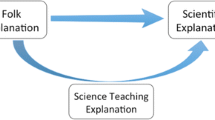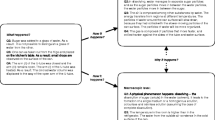Abstract
Stemming from the realization of the importance of the role of explanation in the science classroom, the Next Generation Science Standards (NGSS Lead States 2013) call for appropriately supporting students to learn science, argue from evidence, and provide explanations. Despite the ongoing emphasis on explanations in the science classroom, there seems to be no well-articulated framework that supports students in constructing adequate scientific explanations, or that helps teachers assess student explanations. Our motivation for this article is twofold: First, we think that the ways in which researchers in science education have studied scientific explanation are, at best, leaves much to be desired and, at worst, simply incomplete. Second, we believe that research about the teaching and learning of explanation in science classrooms must be guided by explicit models or frameworks that specify elements involved in constructing explanations particularly applicable to science. More importantly, we think that the development of such models or guidelines should be based on theoretical and philosophical foundations. In order to develop these frameworks or guidelines, we first outline and clarify models of scientific explanation developed by philosophers of science over the last few decades. In the second section of this article, we present a more recent philosophical work on scientific explanation, the pragmatic approach to studying scientific explanations. This approach suggests a toolbox for analyzing scientists’ scientific explanations, which provides a useful instrument to science education. In Section 3, we discuss the ways by which the previous two sections are useful in developing a K-12 scientific explanation schema. Implications for future research on students’ explanations are discussed.

Similar content being viewed by others
Notes
Weber et al.’s (2013) pragmatic approach to explanations should not be confused with the pragmatic account of explanations (e.g., Van Fraassen 1980). One of the most important criterion of the approach is the use of the philosophical accounts as tools to examine explanations, while the pragmatic models of explanation focuses on the contextual aspects with which scientific explanations are constructed.
Weber et al.’s (2013) toolbox includes another answer format for contrastive questions—an alternative to reality format—that is concerned with the reasons behind someone choosing a scientifically incorrect answer to a problem. While important, this format is not relevant to formulating a scientific explanation. It tackles issues such as circumstances that lead to a wrong answer, inadequate skills, etc.
The reader can refer to Weber and Van Bouwel (2009) in which the authors argue that it is nearly impossible to find an acceptable non-causal explanation—hence adding the condition of causality to almost all explanation formats.
References
Achinstein, P. (1984). The pragmatic character of explanation. In P. Asquith & P. Kitcher (Eds.), Philosophy of science (pp. 275–292). East Lansing.
Beebee, H., Hitchcock, C., & Menzies, P. (Eds.). (2009). The Oxford handbook of causation. Oxford: Oxford University Press.
Braaten, M., & Windschitl, M. (2010). Working toward a stronger conceptualization of scientific explanation for science education. Science Education, 95, 639–669.
Brewer, W. F., Chinn, C. A., & Samarapungavan, A. (2000). Explanation in scientists and children. In F. C. Keil & R. A. Wilson (Eds.), Explanation and cognition. Cambridge: MIT Press.
Cartwright, N. (1983). How the laws of physics lie. Oxford: Clarendon Press.
Craver, C. F. (2007). Explanation and causal relevance. In C. F. Craver (Ed.), Explaining the brain: mechanisms and the mosaic unity of neuroscience (pp. 21–62). Oxford: Clarendon Press.
de Regt, H., Leonelli, S. & Eigner, K. (2009). Scientific understanding: Philosophical perspectives, Pittsburgh: University of Pittsburgh Press
Delen, I., & Krajcik, J. (2018). Synergy and students’ explanations: exploring the role of generic and content-specific scaffolds. International Journal of Science and Mathematics Education, 16(1), 1–21.
Feigl, H. (1970). The ‘orthodox’ view of theories: remarks in defense as well as critique. In M. Radner & S. Winokur (Eds.), Minnesota studies in the philosophy of science. Minneapolis: University of Minnesota Press.
Friedman, M. (1974). Explanation and scientific understanding. Journal of Philosophy, 71, 5–19.
Gardiner, P. (1959). The nature of historical explanation. Oxford: Oxford University Press.
Glennan, S. (2002). Rethinking mechanistic explanation. Philosophy of Science, 69, 342–353.
Hausman, D. M. (1998). Causal asymmetries. Cambridge: Cambridge University Press.
Hempel, C. (1965). Aspects of scientific explanation. In C. Hempel (Ed.), Aspects of scientific explanation, and other essays in the philosophy of science (pp. 331–489). New York: Free Press.
Hempel, C. (2001). Deductive nomological vs. statistical explanation. In C. Hempel & J. Fetzer (Eds.), The philosophy of Carl G. Hempel studies in science, explanation, and rationality (pp. 98–169). New York: Oxford University Press.
Hempel, C. (2002). Two models of scientific explanation. In Y. Balashov (Ed.), Philosophy of science: contemporary readings (pp. 45–55). London: Routledge.
Hempel, C. G. (1962). Explanation in science and history. In R. Colodny (ed.), Frontiers of Science and Philosophy. University of Pittsburgh Press, Pittsburgh, PA, pp. 36–54.
Hempel, C., & Oppenheim, P. (1948). Studies in the logic of explanation. Philosophy of Science, 15, 135–175.
Hogan, K., & Maglienti, M. (2001). Comparing the epistemological underpinnings of students’ and scientists’ reasoning about conclusions. Journal of Research in Science Teaching, 38, 663–687.
Humphreys, P. (1989). Scientific explanation: the causes, some of the causes, and nothing but the causes. In P. Kitcher & W. C. Salmon (Eds.), Scientific explanation (pp. 282–306). Minneapolis: University of Minnesota Press.
Kampourakis, K., Silveira, P., & Strasser, B. J. (2016). How do preservice biology teachers explain the origin of biological traits?: a philosophical analysis. Science Education, 100, 1124–1149.
Kitcher, P. (1981). Explanatory unification. Philosophy of Science, 48, 507–531.
Kitcher, P. (1989). Explanatory unification and the causal structure of the world. In P. Kitcher & W. C. Salmon (Eds.), Scientific explanation (pp. 410–499). Minneapolis: University of Minnesota Press.
Kitcher, P. (1997). Explanatory unification. In D. Rothbart (Ed.), Science, reason, and reality: Issues in the philosophy of science (pp. 167–186). Fort Worth: Harcourt Brace.
Metz, K. (1991). Development of explanation: incremental and fundamental change in children’s physics knowledge. Journal of Research in Science Teaching, 28, 785–797.
Nagel, E. (1961). The structure of science: problems in the logic of scientific explanation. New York: Harcourt, Brace and World.
National Research Council. (2012). A Framework for K-12 Science Education: Practices, Crosscutting Concepts, and Core Ideas. Washington, DC: The National Academies Press. https://doi.org/10.17226/13165.
NGSS Lead States. (2013). Next Generation Science Standards: For States, By States. Retrieved from http://www.nextgenscience.org/.
Parnafes, O. (2012). Developing explanations and developing understanding: students explain the phases of the moon using visual representations. Cognition and Instruction, 30, 359–403.
Peker, D., & Wallace, C. S. (2011). Characterizing high school students’ written explanations in biology laboratories. Research in Science Education, 41, 169–191.
Popper, K. (1959). The logic of scientific discovery. London: Hutchinson.
Railton, P. (1978). A deductive-nomological model of probabilistic explanation. Philosophy of Science, 45, 206–226.
Salmon, W. C. (1971). Statistical explanation and statistical relevance. Princeton: University of Pittsburgh Press.
Salmon, W. C. (1984). Scientific explanation and the causal structure of the world. Princeton: Princeton University Press.
Salmon, W. (1989). Four decades of scientific explanation. In P. Kitcher & W. C. Salmon (Eds.), Scientific explanation (pp. 3–219). Minnesota: University of Minnesota Press.
Salmon, W. C. (1998). Causality and explanation. New York: Oxford University Press.
Scriven, M. (1958). Definitions, explanations, and theories. In H. Feigl, G. Maxwell, & M. Scriven (Eds.), Concepts, theories, and the mind-body problem (pp. 99–195). Minnesota: University of Minnesota Press.
Skipper, R. (1999). Selection and the Extent of Explanatory Unification. Philosophy of Science (Suppl.), 66, S196–209.
Van Fraassen, B. (1980). The scientific image. Oxford: Clarendon Press.
Weber, E., & Van Bouwel, J. (2009). Causation, unification, and the adequacy of explanations of facts. THEORIA. Revista de Teoría, Historia y Fundamentos de la Ciencia, 24, 301–320.
Weber, E., Van Bouwel, J., & De Vreese, L. (2013). Scientific explanation. New York: Springer.
Weinberg, R. (1985). The molecules of life. Scientific American, 253, 48–57.
Woodward, J. (2003). Making things happen: a theory of causal explanation. Oxford: Oxford University Press.
Woody, A. I. (2013). How is the ideal gas law explanatory? Science & Education, 22, 1563–1580.
Yang, H. T., & Wang, K. H. (2014). A teaching model for scaffolding 4th grade students’ scientific explanation writing. Research in Science Education, 44(4), 531–548.
Author information
Authors and Affiliations
Corresponding author
Ethics declarations
Conflict of Interest
The authors certify that they have NO affiliations with or involvement in any organization or entity with any financial or non-financial interest in the subject matter or materials discussed in this manuscript.
Rights and permissions
About this article
Cite this article
Alameh, S., Abd-El-Khalick, F. Towards a Philosophically Guided Schema for Studying Scientific Explanation in Science Education. Sci & Educ 27, 831–861 (2018). https://doi.org/10.1007/s11191-018-0021-9
Published:
Issue Date:
DOI: https://doi.org/10.1007/s11191-018-0021-9




